IN A NUTSHELL:
WHAT TO EXPECT: Untraditional fantasy themed RPG. With roguelike structure. Strategy elements & turn-based tactical battles. Party-based assignments with selectable characters. Great character customisation. Numerous multi-chapter campaigns. Seed generated world maps. Personalised character-driven, scripted and randomly occurring story-rich events in a comic book format. Very polished artisanal level production values. 2.5D papercraft stylised combat locations. Card-based enemy generating roster. Environment-based, infusion-geared magic system. Restrictive perma-assigned inventory. Multi-generational adventuring. Bona-filed legacy system allows recruitment across campaigns. Physical transformations for character. Growing Steam workshop support. Single-player & multiplayer coop.
ACHIEVEMENTS: TIME INVESTMENT REQUIRED.
STATUS: COMPLETE. STILL BEING SUPPORTED.
WHEN TO BUY: ASAP. ITS A NO BRAINER.
More info below….
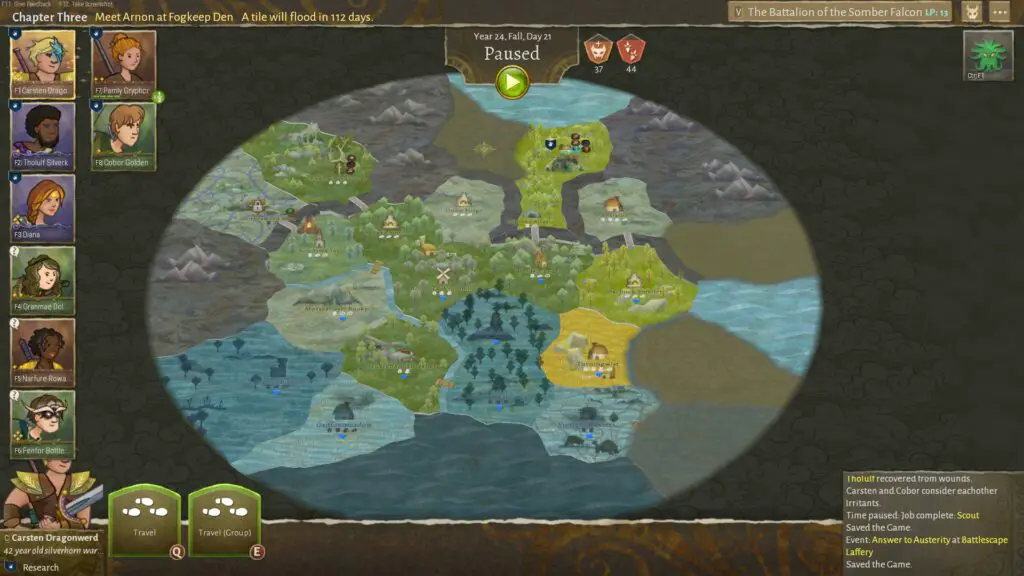
THE LOWDOWN:
Wildermyth delivers its own highly stylised take on the fantasy-themed strategy RPG genre. Among it core aims is to impart a real sense of party-based, table-top roleplaying. Producing an intimate experience, across several multi-chapter campaigns. One that is very replayable due to its design philosophy. It attempts to achieve this by incorporating a host of elegantly crafted features with party-based mechanics. Wrapped within elements of a roguelike structure. All infused with artisanal quality, hand-drawn artwork and a soundtrack that provides adds to the general ambience.
Players take on a small but highly customisable, party of characters. Helping them rise from humble beginnings. To aspire and become authentic legends. Along their journeys, characters will take part in scripted adventures crammed with a mix of colourfully represented stories, triggered by scripted and random events. Requiring important choices to be made. Resulting in a range of bonuses or penalties; boosting combat factors, strategic rewards, or delivering a range of setbacks. Even death.
Wildermyth is a world of occupied lands, on a procedurally seed-generated map. Full of provinces in need of liberation. So they can be upgraded when freed, with limited infrastructure to protect them from incursions while also generating valuable resources. The collection of which will allow the crafting or upgrading of perma-assigned inventory. Boosting character stats, essential when fighting a host of tactical turn-based battles against a growing roster of five unique enemy species. Fought upon a selection of pre-generated combat encounter maps.
Where victory can only be achieved by using a combination of weapon attacks, character abilities, environment dependent magic and a handful of tactical factors to overcome the current crop of dynamically assigned foes. To level characters and ready them to face and defeat an end of level boss. In order to progress to the next chapter in the campaign. Enabling them to reach the end of their current journey and propel them towards inimitable legacies of their own. Eventually joining a heroes pantheon. Thus reaching the accolade of true legends and becoming recruit-able in future campaigns.
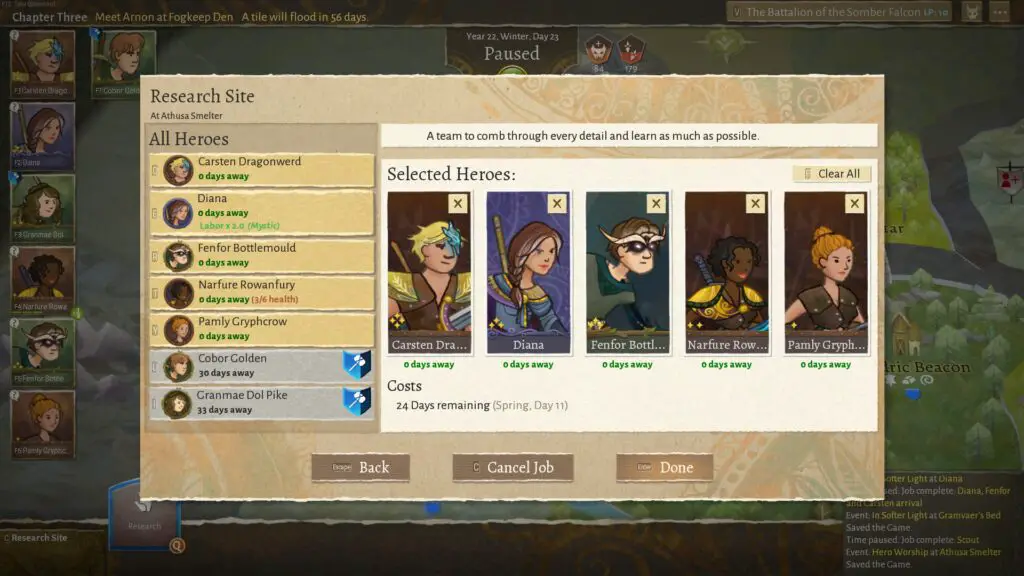
The game currently contains a sizeable amount of content to play and replay. Given a design philosophy geared towards randomisation and the use of RNG, it has good replayable qualities. Comprehensive workshop support, already provides a good number of player made mods. Resulting in a game with good longevity ahead of it.
Key features are explored in greater detail below:
ARTISANAL PRODUCTION
From the very first screen Wildermyth emanates an impressive sense of quality in its production. Resonating through the hand-drawn comic book style presentation of its stories, across papercraft styled battle maps. Emphasised in the 2D hand-painted characters and scenery, shining through the accessibly designed GUI. Complemented by some pinpoint writing. Generating a delightful ambience perfectly augmented by some cracking audio and a soundtrack that ties everything all together. A total artisanal effort.
FROM HUMBLE BEGINNINGS
The experience begins with the selection of a multi-chapter campaign to play. To customise the difficulty setting for both strategy and tactical game elements. If so desired. Followed by including any desired workshop mods. Before randomly generating a trio of starting characters. One of each class: warrior, hunter and mystic. Customising these to preferred appearances, voice types and even sexual preferences. Finishing up by bestowing a name to the adventuring company they will form and make famous.
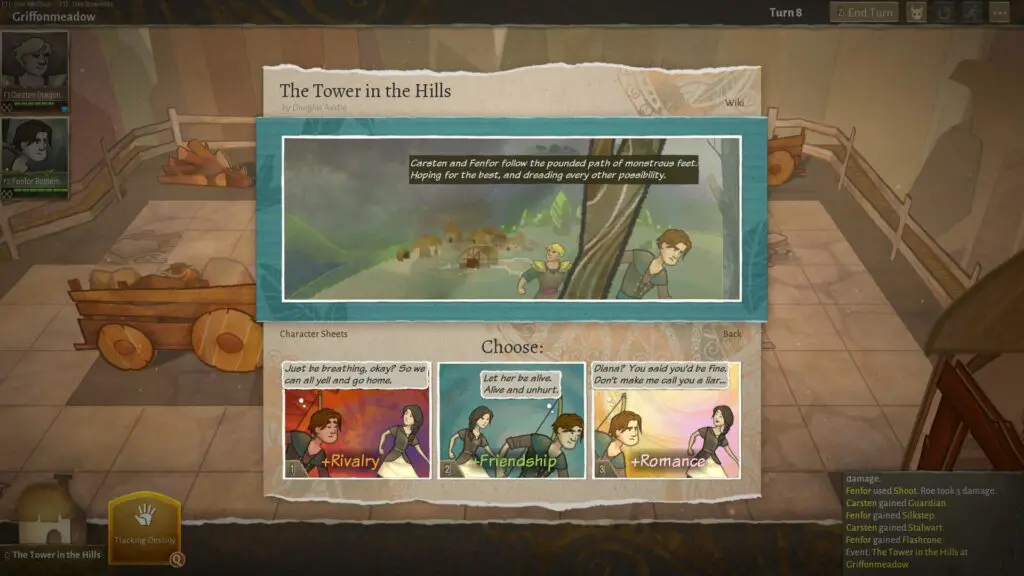
A GAME OF ROLEPLAYING
At Wildermyth’s core is a vehicle that lets the player take a group of bon-a-fide ordinary folks on a journey, to become heroes and over time legends. Players have the ability to create a set of characters based on three basic classes; Warrior, Hunter and Mystic. Each of these can be customised in great detail. From their appearance to their voice overs. Even personal histories. Tactical sub-classes or roles can also be determined through the careful selection of abilities. So if a tank is desired, a warrior can be plied with extra health, the ability to protect and even allow them to stand guard on overwatch. Auto-attacking enemies that get to close to injured party members.
More than these, Wildermyth provides some truly personalised touches to character growth. Relationships between character drive the stories in which those characters are present. While there are only three types (romance, friendship and rivalry) these can take significant storylines in certain directions. Characters can get married and produce offspring that continue the journey, if and when their parents become old and retire.
ONCE UPON A TIME
Stories form a large part of the gameplay. Presented in a comic book fashion with some impressive hand-drawn artwork, driving the narrative of the adventure for the chosen campaign. They are initiated through key events and randomly occurring opportunities, when triggered on the overland map. These are further personalised with the superimposition of character images over specific backdrops. The images of these character changes as they change. With adornment of clothing, accessories, held weapons, any transformations that have taken place or any maiming received as a result of near death experiences. They will also appear to age as the character becomes older. Also updated and seen are any physical transformations that can affect characters both visually and physically which replace human capabilities with superior tactical abilities but at a cost.

LAND OF STRATEGY
From small beginnings the adventuring company starts in a designated home province. With the game on pause. Characters are formed up into parties and issued orders to scout neighbouring provinces, under a fog of war. Once the game is un-paused these parties travel to their objectives across the map in real-time. Discovering what enemies lie therein and engaging them in battle in the hope of eradicating their presence. Thus liberating provinces of enemy infestations. If left unchecked these can generate ambushes directed against any characters at or passing through the location and can even manifest dangerous incursions into other provinces if left untouched.
Once free from enemy control resource generating stations can be built within the province. The choice of installation determining which of five resource types will be generated at the end of every chapter. Each of these will contribute to the crafting or upgrading of a particular garment, accessory, weapon or other piece of equipment in a character’s inventory. At their behest players can build defences in provinces, to help ward-off future enemy incursions. In some cases some unreachable provinces will require the construction of bridges or passes. To allow movement into those territories. Tombs can also be built to the fallen. Bestowing a bonus when built.
As play continues additional wannabe adventurers appear periodically, ready to be recruited. Once prepared – another quest, they can join the ranks of the adventuring company. Ready for their own assignments. The playable territory on maps expands with the commencement of a new chapter. Enlarging the game world. Adding new provinces that require liberating and expanding.
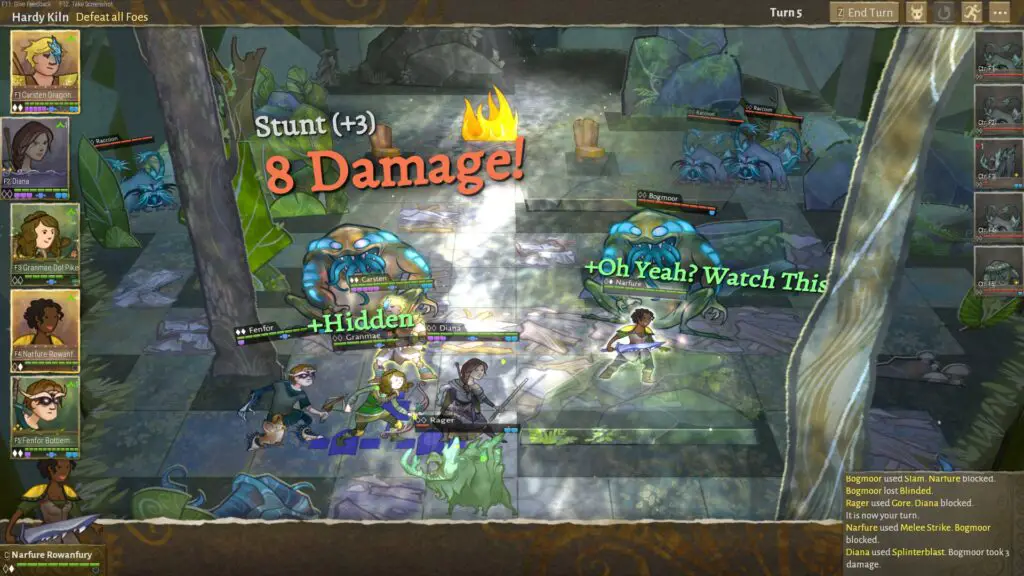
IMPORTANT EVENTS
Story-led events are relayed throughout the game in the fashion of a comic-book, usually ending in an important resolution or a significant choice to be made. During the recanting of these sometimes substantial segments, certain characters interact with each other. Some result in the party entering combat. Others will see characters fall in love and even procreate. With their offspring joining the band of adventurers later on. In some encounters characters will become rivals. Additional events may present select characters to be presented with the option to transform into other-worldly creatures. Taking on their limitations and unique abilities. All of these milestones will significantly impact future events and stories told during that campaign.
THE THEATRE OF COMBAT
Combat occurs in turns on pre-generated, square-tiled 2.5D maps, with a distinctly papercraft look and feel. Between three and seven party members take part, with five being the median number. In some encounters NPC allies may temporarily join the fight. Actions are initiated in turns. Characters can move, attack or use class-based tactical abilities. These are considerable and wide-ranging. Delivering an advantage when cleverly used in unison. The difference between victory and defeat; or losing or not losing a character. The bulk of battles result in victory if all enemies are destroyed. Some encounters require the group to flee, to escort an NPC to an exit tile or to keep them alive for the duration of combat.
Battles encompass numerous mechanics that provide tactical options. Scenery provides cover, blocks line-of-sight or is the catalyst for magic to take place. Five weapon types provide specific benefits to damage, range, blocking, accuracy as well as knocking back enemies. Some are ranged, including melee weapons. Walling allows characters to gain protection from damage simply by being adjacent to allies. Flanking lets attackers gain 100% chance of hitting an opponent. Combatants can remain out of view, only becoming visible when moving within spotting range.

Enemies are generated from a roster and only those selected before an encounter will be present. They can sometimes appear in waves. While some battle maps have respawn tiles where additional enemies of the types allow can continue to appear until an objective is completed or an exit hex has been reached.
Some characters can enter the grayplane, a dimension with a similar effect to Frodo putting on Sauron’s ring. Giving character the element of surprise. What’s more fires can play an important tactical role in combat. Not only can they be used to block movement, they can spread and cause damage to enemies. Though their unpredictable nature means damage can occur to friendlies as well. There are also two undo actions per encounter. Allowing for the correction of key mistakes if made by accident. If a battle seems unwinnable or the cost of remaining in the fight appears to high, the party can withdraw at the click of the button. Though there is a delay in its completion.
ITS A KINDA MAGIC
Wildermyth uses an element-based magic system to allow the mystic character class and some enemies to cast spells during combat. Individuals infuse their essence with certain objects on the tactical map rather than relying on a mana pool, items or scrolls. The object determines which spell effect can be cast against an enemy. Once infused with the caster the player selects the spell to cast from the character’s ability list. Only enemies within the range of the object from where the spell originates from can be targeted. Some spells can cascade damage or effects beyond the first target. While others have an area of effect. It is also possible to cause friendly fire with uncareful targeting.
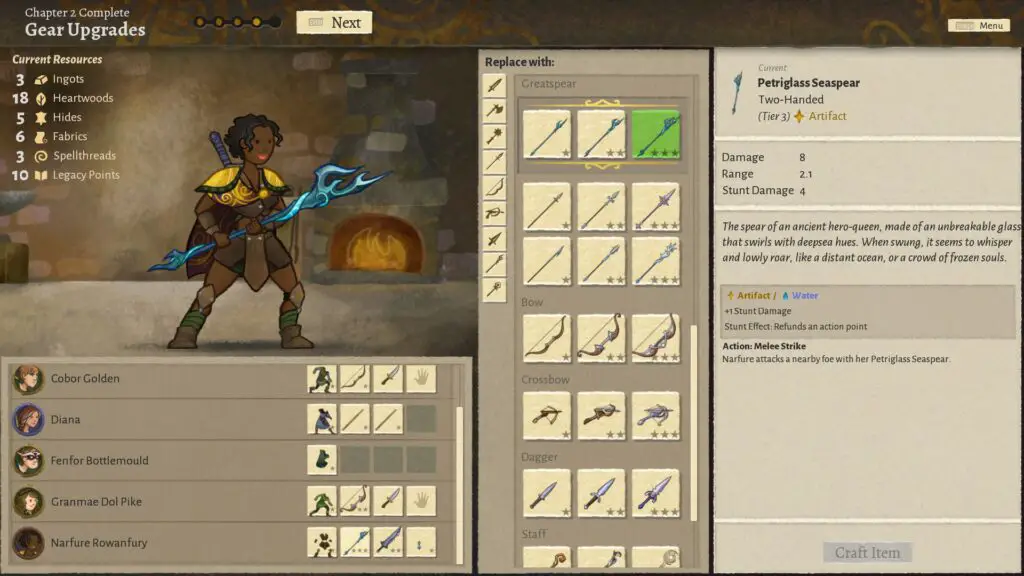
A CALAMITOUS ROSTER
Enemies in this game are non-standard fare with five unique species comprising of a dozen or so enemy types. A card-based roster system called Calamities keeps track of which of these are available at any given point of a chapter.
Enemies can be added to this roster in a number of ways, though mainly after battles. Only the enemies currently on there can be designated to an encounter, which is performed by random assignment.
Along with additional enemies cards that augment a monster’s level or raise one of four key abilities are also added. Making them stronger, more resilient and deadlier. All of these cards are automatically added to the roster. Yet during some occurrences players are given the choice obstruct some of these cards by spending legacy points. In addition at the completion of every chapter some cards are removed from the roster as a result of the chapter victory diminishing the strength of the enemy.
PERMANENTLY SHINY BAUBLES
Unlike traditional RPGs, Wildermyth uses a focused item and inventory model. Only a maximum of two weapons and shield combinations can be equipped plus limited clothing and jewellery can be worn. All of which are designed to boost character stats. There is no communal inventory to speak of, restricting micromanagement to a minimum. This results in items that are not only scarce to find but every one invaluable. Moreover the weapons and items can only be assigned to one specific character. Becoming a permanent fixture of their inventory once assigned to them. They cannot be re-assigned to other characters. Binding to them for the duration of the entire campaign.
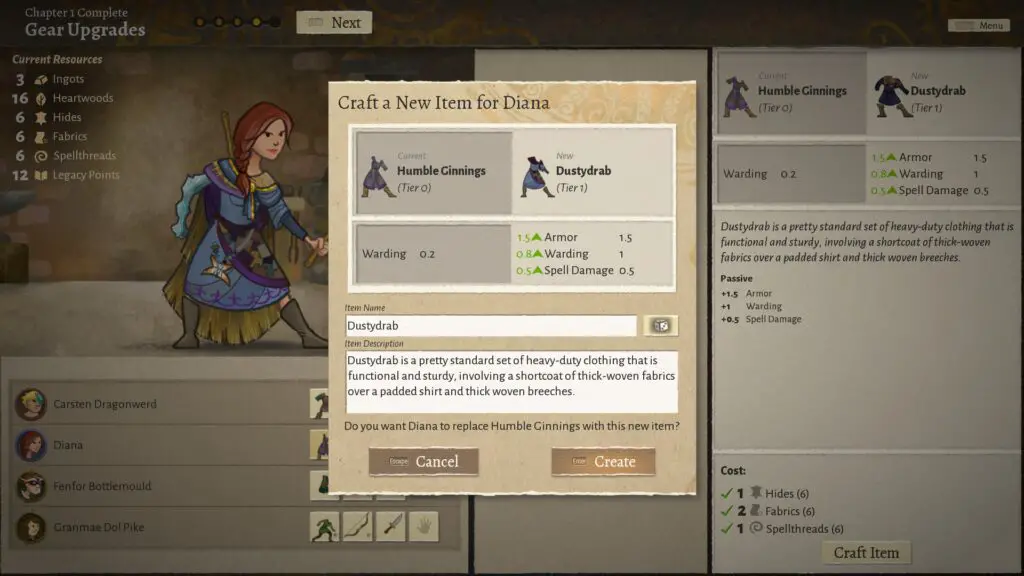
With no shop to purchase equipment from, items are scarce. They are can only be found as a reward after winning a battle, when stations are first constructed or as the result of an event. They must otherwise be crafted. Weapons, clothing and accessories comprise of only a few dozen types that come in four and three tiers. If an item is unwanted it can be dismantled for resources. These are used in upgrading existing items or crafting new ones. This can only be performed at the home province during the course of a chapter or instantly if attempted between them. If not enough strategic resources have been collected Legacy Points can be used to make up the shortfall.
TRANSFORMERS: CHARACTERS IN NEW GUISE
Throughout their adventures characters will have the opportunity or bad fortune to begin mutating into non-human forms. Called Transformations these physical changes begin through story-driven events or during the trauma of combat, when a character is about to die. Depending on specific circumstances a part of the their body will alter into something that is non-human. Bringing with its own advantages and disadvantages that affect stats or otherwise confer unique tactical abilities to the recipient. As a consequence removing their ability to use weapons.
Progressing through chapters allows for additional transformations to take place increasing the mutations possessed by individuals. At end of every chapter characters with transformations have the option to intensify these if the player so desires, until the transformation is complete.
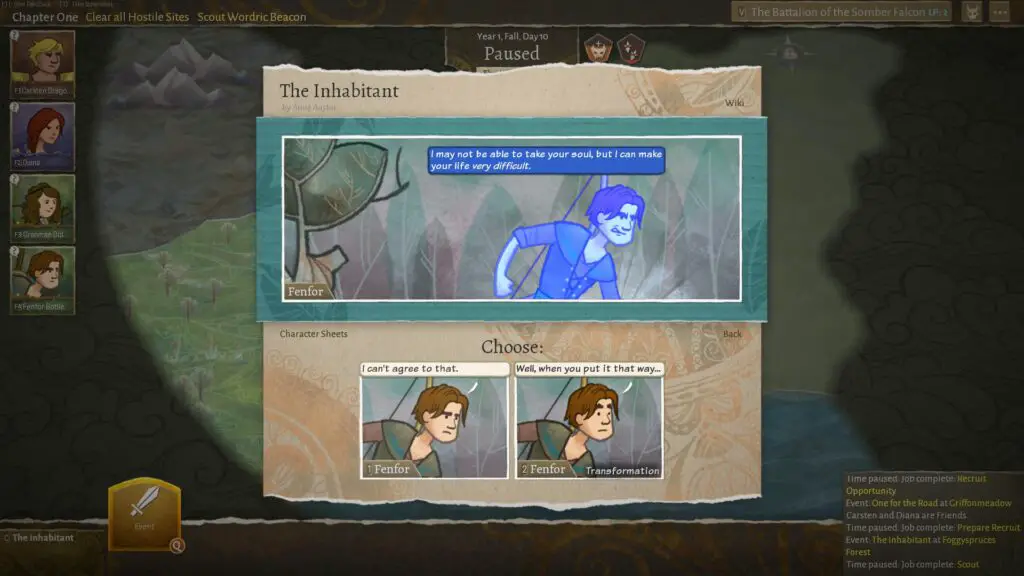
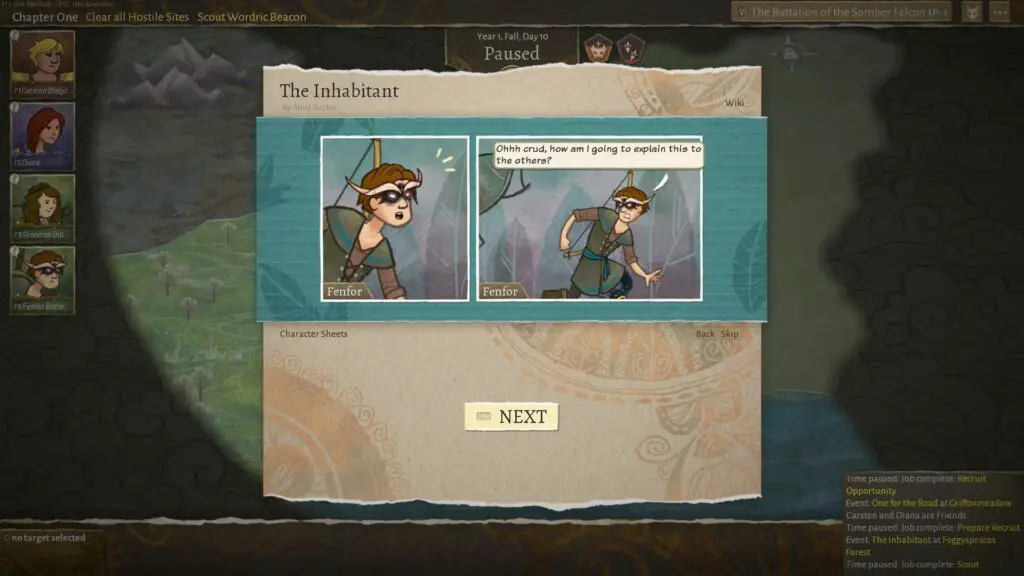
THE CURRENCY OF LEGACY
Legacy Points are awarded for the completion of quests, tactical battles, liberating occupied lands and choosing certain options during events. Even completing chapters. These accumulate over the course of the game and are necessary for many strategic actions. Their most high profile usage is to stop Foe cards from joining the roster during Calamities. They are also needed to recruit new characters into the adventuring company and the building of provincial stations. Shortfalls in resources required for any crafting can sometimes be made up with Legacy Points. If enough have been accumulated characters residing in the heroes pantheon can be recruited instead of novice characters. Albeit with a reduced profile and limited inventory items. Without enough Legacy Points the game becomes harder if Calamities are left to run riot.
END OF THE ROAD: DEATH, RETIREMENT & LEGACY
In nearly every CRPG characters either live to complete their quest or die prematurely if not up to the task. In Wildermyth they can also retire if they reach a certain age. Either way their adventuring days for that particular session are over. However unlike alot of CRPGs, the game is designed to be played and replayed across many adventures. Using both new characters and sometimes those from previous games, just like modules from table-top/pen and paper versions.
Death is also not certain in Wildermyth. It is handled a little more creatively. Characters who are about to die in combat receive an event choice. They can accept their fate sometimes giving a boost to surviving comrades who remain in combat. Alternatively they can delay their fate; sometimes receiving a life altering injury that maims them permanently or as mentioned above begin a transformation into something non-human.
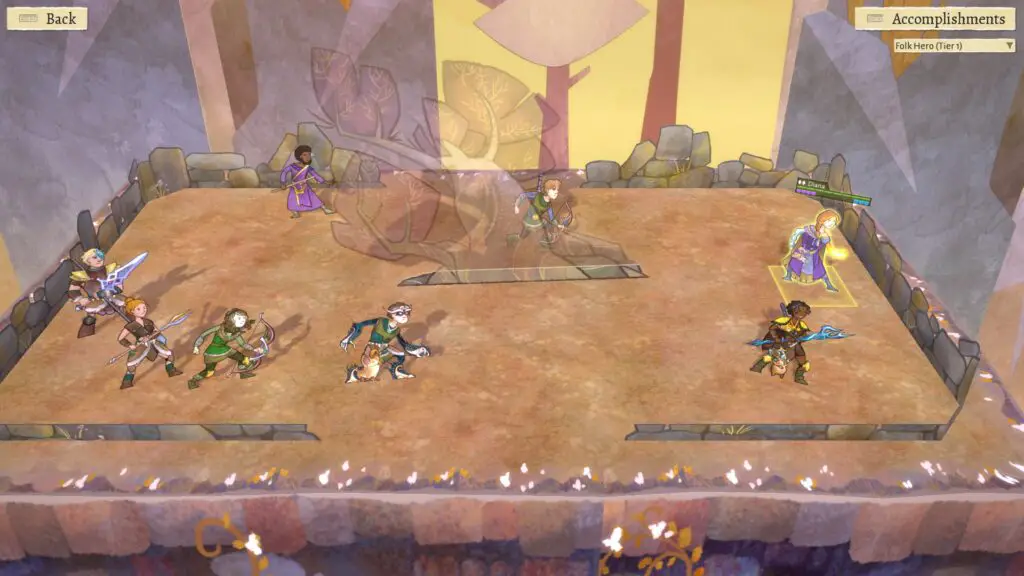
When a character’s adventure is finally over they are sent to a pantheon of heroes. Receiving a rank that represents a level of renown, of which there are five. With every game the player manages to complete some of these heroes can be promoted to an additional rank. Eventually becoming true legends to be remembered through generations to come. Promotions are limited and rare so selecting which heroes are worthy of growing in stature is another strategic decision in need of contemplation.
LONGEVITY, WORKSHOP & COOP
Anyone unsatisfied at already sizeable amount of content within its base game can sign up for additional content through workshop support. Even if at this time the scope of support for some components remains limited (as hinted at by the devs). Currently there exist nine categories of game mods available. As well heroes, transformations, events and abilities, there are already six additional campaigns to try. Balance changes, monsters and items can also be added to tailor player’s individual preferences. Even additional translations are available. The devs have also indicated that workshop support will be increased as time permits.
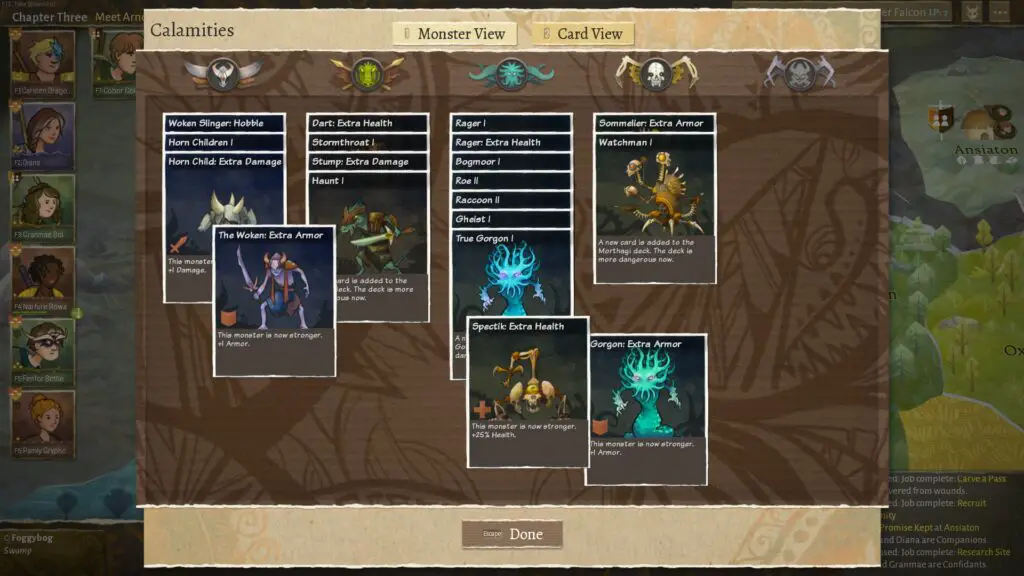
THE GOOD:
- Delivers a very strong pen & paper/tabletop roleplaying experience. Especially through the superimposition of characters into the story elements.
- Personal and purposeful story-telling in a detail-filled comic book style. Told from character viewpoints.
- Eminently customisable characters with an intimate quality that live ‘lives’ and can be used in future adventures.
- Robust turn-based tactical combat battles with an emphasis on character abilities.
- Distinct magic system relying on infusing with the environment to allow different spells to be cast.
- Five distinct enemy races with an encounter determining roster that includes upgrades to stats and model types.
- Lots of beautifully crafted artisanal quality artwork. In all aspects of its visual aesthetics.
- Supporting instrumental soundtrack. Adds to the overall ambience.
- Strong replayable qualities embedded throughout its design.
- Handles death, near-death and retirement in a refreshing and fair way.
THE BAD:
- Stories can take a lot of time to read slowing progress down.
- The personal and intimate nature of inventory and looting may prove to be overly restrictive.
- Missing complete dungeon master and character voice-overs. To give that extra special aesthetic.
- Cannot craft upgrades for equipped accessories.
- Campaigns played are somewhat different but the potential for feeling samey if played for long enough is real.
- No other interaction within tactical combat, except for movement, combat and abilities.
- Would love to have seen the ability to choose the company flag/banner.
AND THE REST:
- Uncomplicated overland strategy elements. Research sites to generate resources to craft items.
- Variety in battle is provided by some compact tactical factors; positioning, flanking & stealth, cover providing scenery, limited overwatch. Can undo actions 2x per encounter.
- Simplified looting and inventory management.
- Post chapter utilisation of resources and legacy points to craft and upgrade inventory.
- 5x distinct enemy species with a number of sub-classes. A good start.
- Periodic incursion keep a player on the toes as it does keep the world map relevant.
- Character transformations are a neat touch.
- Magic spells are basic but varied.
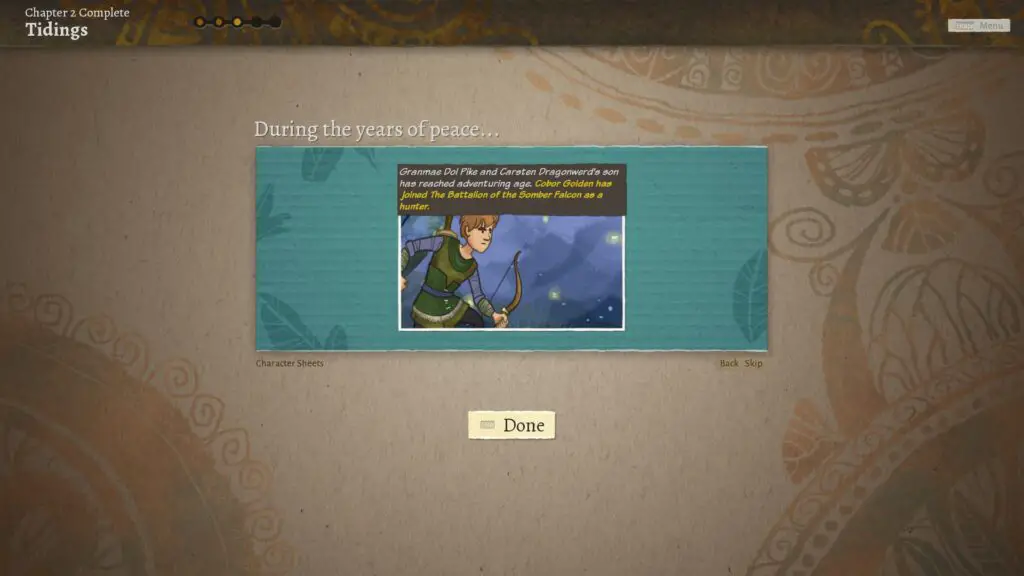
ANALYSIS:
Wildermyth’s biggest aim looks to have been to provide an CRPG experience as akin to pen & paper/table-top roleplaying, as could be achieved in a video game. With that in mind a close inspection of its features and gameplay indicated many successes. Even if some of these were lukewarm in their delivery. From the very beginning it was impossible to ignore just how wonderful the visuals in this game were. The hand-drawn nature of the comic book storyboards, the detailed character sheets, strategic maps, papercraft looking combat locations and the heroes pantheon; everything produced appeared polished and crafted to an artisanal level. All complemented by a suitably fable-esque aesthetic generated by some similarly artisanal quality sounding audio.
STORY
With the role of the Gamesmaster being taken over by scripted and event-driven story-boards, the mechanism by which these were conveyed to the player would need to be something special to compare to a human. In its attempt at reaching this level, Wildermyth succeeded with an impressive delivery system full of beautifully hand-drawn backgrounds. The superimposition of characters from the party gave the narrative the feeling of relevance. As did the change in appearance throughout the journeys of the characters. Aging, gaining of injuries, changes to clothing and equipment and physical transformations all were relayed in the stories, creating a personalised feel. Relaying an intimate sense of story-telling that is rare to find. At least in many of RPGs I can remember playing.
The bulk of the writing was concise and articulate. Interesting to a degree but not always engrossing. Sufficient to keep players invested in the characters and their adventures. There was a lot to read. So player looking for more of a ARPG approach to narrative will be skipping these sections. Which will lessen the experience quite a bit given the background and context that is provided.

CHARACTERISATION & CUSTOMISATION
Initially it was disappointing to only have three character classes to choose from. However being able to define ad-hoc sub-classes through the selection of abilities tempered this a little. So if players wanted a warrior they could go all out attack, all out defence or a mixture of both.
The depth of character customisation options was good. With players being able to choose the sex and race as well as a complete range of physical attributes. Hair colour, face types, even voice-overs could be set or randomly configured if in a hurry. Every minor change to the character was impressively updated in their visual representations across various screen; the permanently assigned weapons, clothing and accessories, the injuries, the change of age and the transformations, the character’s avatar changed in appearance. This updated visualisation bought with it a certain level of immersion, felt throughout every aspect of the game.
What would have made the role-playing aspect of Wildermyth even better was to build on the three relationship types. For instance having offspring assigned a teacher who they would have to shadow for a number of battles would have added another dimension to relationships. Perhaps having certain enemies becoming the nemeses of characters who they had badly injured. Conferring an additional penalty or even possessing the chance of causing character to freeze in combat if within sight of one of these feared opponents. Then allowing characters to overcome their fear by killing x enemies of that type would have deepened roleplaying even more. Flipping the effect would have built on this even more. Whereby an adventurer who killed y enemies, would gain a bonus when fighting such foes. The list of possibilities is endless. Fingerscrossed modders take up any chance to add anything close to these into the game.

STRATEGIC GAMEPLAY
The use of procedurally map-seed generated maps, generated a fair amount of replayability when it came to the strategy layer. The plain looking landscape served as a capable platform for the party of adventurers to conduct their quests and gave the game world a feeling of somewhere to explore. There was enough to do. Barely! On easier difficulties there was an unescapable feeling that activities dried up after liberating, upgrading, building defences and a stations in provinces. Alot of the time defences were not even needed, an issue with balancing.
On harder difficulties with more frequent and deadlier incursions it may come to pass that the strategic situation will actually see-saw. So that once liberated provinces are retaken with more frequent incursions and harder infestations to deal with. If this is the case it will keep this portion of the game more relevant for longer. Overall this element of the game felt made to provide a streamlined vehicle for the turn-based tactical battles and not much else. Though if it were to become overloaded, the heart-beat of the game would begin to feel more like a strategy game than an RPG.
TACTICAL GAMEPLAY
Fighting battles was one of the game’s features that really shined. Visually the papercraft 2.5D battle locations had the look and feel of theatre stages. Invoking the sensation of watching a theatrical show taking place. With combat taking place on the same pre-generated maps an inevitable sense of deja’ vu eventually presented itself. There were plently though towards the end of a second campaign the same maps began to be used more frequently.

The combination of factors that combat relied upon; environmental, mechanics and character options, meshed together to provide encounters that for the most part were intriguing to plan out and fairly easy to execute. On easier difficulties only some encounters surprised but this was infrequent. On the few attempts at a harder difficulty (one below the toughest) there were alot more tougher engagements. Towards the end of my second campaign combat had begun to somewhat repetitive. Mainly due to the favouring of certain abilities over others, for some classes. Perhaps building characters up differently could have made a noticeable.
Magic worked similarly to other features of the game. Simple yet effective, designed with a light touch. Streamlined in its use. Having the environment used up in some incantations of the spell, ensured that this powerful tool would need to be saved for deadlier targets. Magic was further balanced by giving enemies the chance to avoid their effects totally. The range of initial spells was quite good. Although most of the spells were neither over or under-whelming, some of the spells available at higher level were quite satisfying. But from experience these are only likely to come in five chapter campaigns.
Healing was restricted which some players may have to grapple with at the start of games. There are no potions or healing spells to speak of. It is only available as an ability. Making it another tactical tool. Especially as friendly fire is a possibility during combat. Overall this aspect of Wildermyth had enough variation to make it fun but it will remain to be seen if combat eventually becomes an overly repetitive aspect of the game or whether modders will be able to add enough additions and variations to keep it from become mundane. This should not be an issue for new players on their first few adventures.

ITEMS & INVENTORY
The nature of the inventory system may not be everyone’s cup of tea. It was restrictive with only a small pool of in-game items. This approach may be a god-send to those of us who do not enjoy micromanagement. Especially when having to sort through obsolete items. However players that do enjoy hoarding items like a pack-rat, will be disappointed at this approach. The emphasis of inventory and equipping items remained purely on increasing the stats of a character with each item assigned to them.
Finding and receiving items as rewards was another balanced aspect. This meant every find was potentially very important. While assigning them to a particular character more so. The perma-assignment of weapons, armour, clothing and other accessories provided another strategic element to decision making. With no way to correct mistakes, these actions needed to be thought out very carefully. Lest an item be given to a character that would receive a better item in the near future.
The dependence of crafting or upgrading item on the number and types of resources kept this feature balanced on another level. With the possibility of crafting a handful of items at the end of each chapter with the use Legacy Points when resources were not abundant did provide the player the opportunity to lift a weakened party. But gave the player another headache. Ultimately though the impact of weapons was really only felt once level two weapons were assigned to a character. Most of the time during a chapter there would be only enough items to kit out maybe one or two characters to a decent level. It took progression through a campaign to see the majority of the party kitted out to near capacity.
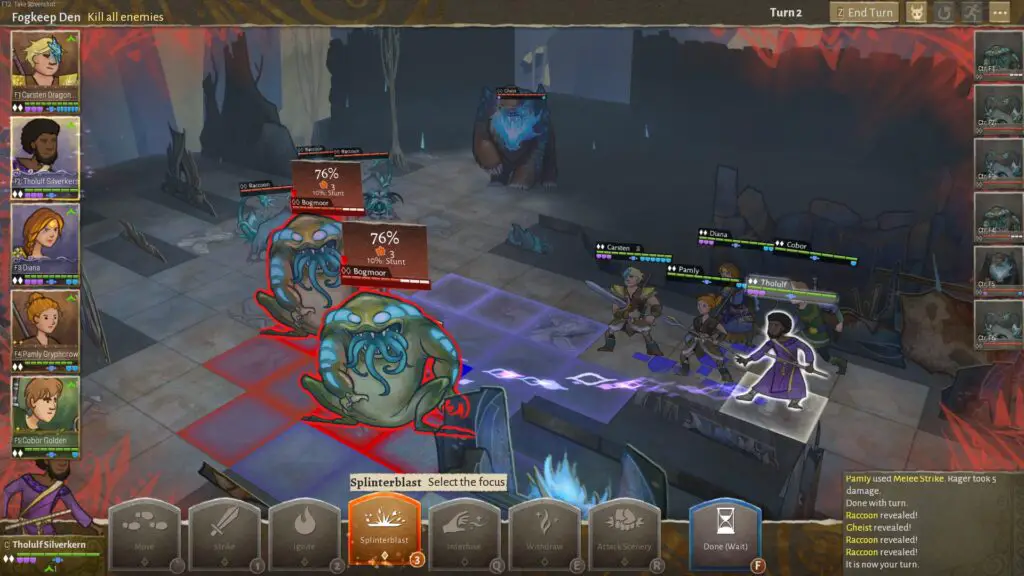
REPLAYABILITY & LONGEVITY
Packed to rafters with tons of features Wildermyth, already stands shoulder to shoulder with AAA titles. With the multi-chapter campaigns provided there is well over fifty hours of play, even if each one is played only once. Add to this the expected inevitable support that modders are sure to provide and potentially this game will have many hundreds of hours. All this without even mentioning the possibility of playing campaigns in coop with other players. An exciting prospect if the connectivity isn’t a problem
By using an open design that encompasses the attributes of a roguelike, it should be no surprise where this game stands in the philosophical contest between depth and replayability. As expected the gameplay loops are shorter than traditional RPGs that go for depth and a continuous developing story. Wildermyth instead opts for a shallower experience across its layers. With repetition of gameplay processes. The strategic layer is probably the weakest of the lot. Appearing somewhat unbalanced in games with lower difficulty. Perhaps this will not be so for casual gamers, yet on harder difficulties it very likely that world map will not feel as stagnant as more incursions take place, ever more frequently. Hard to say for sure with only two campaigns under the belt, but it did look that way.
Another big plus had to be the possibility of replaying the same campaigns with different characters or new campaigns with the characters promoted to the heroes pantheon. Indeed the challenge of getting as many of these beloved characters to the highest rank of legendary accomplishments is sure to resonate among the hardcore RPGers.
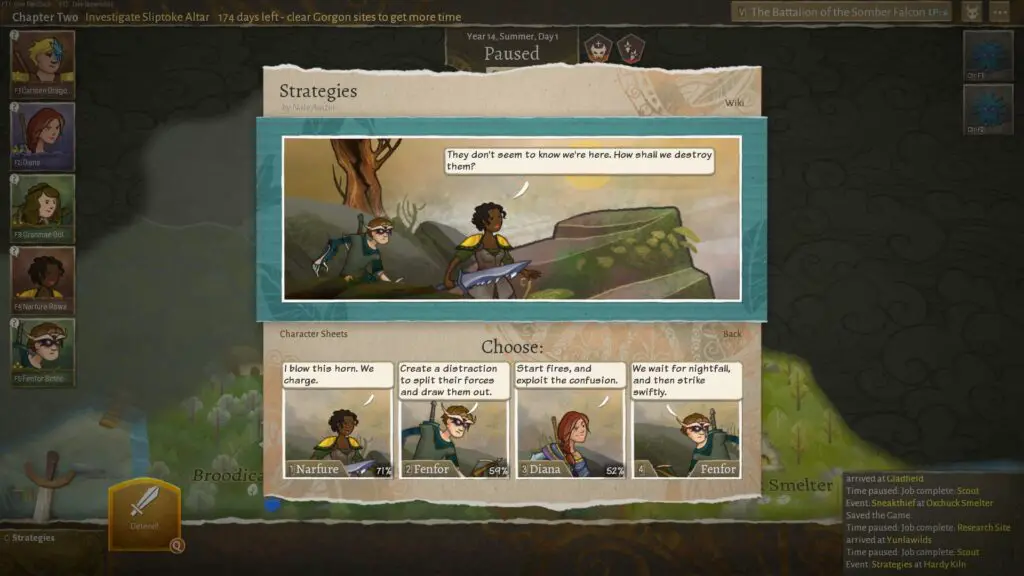
VERDICT:
Wildermyth proved to be very enjoyable. Bewitching with it hand-crafted visuals, which were great to look at. The papercraft battle maps invoked a sense of theatre. While gameplay was straightforward to get into. It was fun to play and very addictive at the start. It surpassed its aim of delivering a bon-a-fide pen & paper/table-top experience with aplomb.
Its delivery of a untraditional RPG with a partial roguelike structure, strategy elements and TBT combat created an experience that will be hard to find elsewhere. Perhaps it gameplay could be closest seen in X-COM games. All of its elements [and there are many] are robust, polished and while its gameplay may not be as deep as the best RPGs, as a collective of components Wildermyth stands shoulder to shoulder with the crème de la crème. Unbalanced difficulty could be the only issue; with novice players finding harder difficulties too hard and veteran fans of genre find gameplay to easy.
The inclusion of transformations, perma-assigned inventory, an augmenting, self-balancing enemy roster and a good legacy model that allows past heroes to join future adventures just added a cherry on top. Reaching heights that made recommending this game very easy.


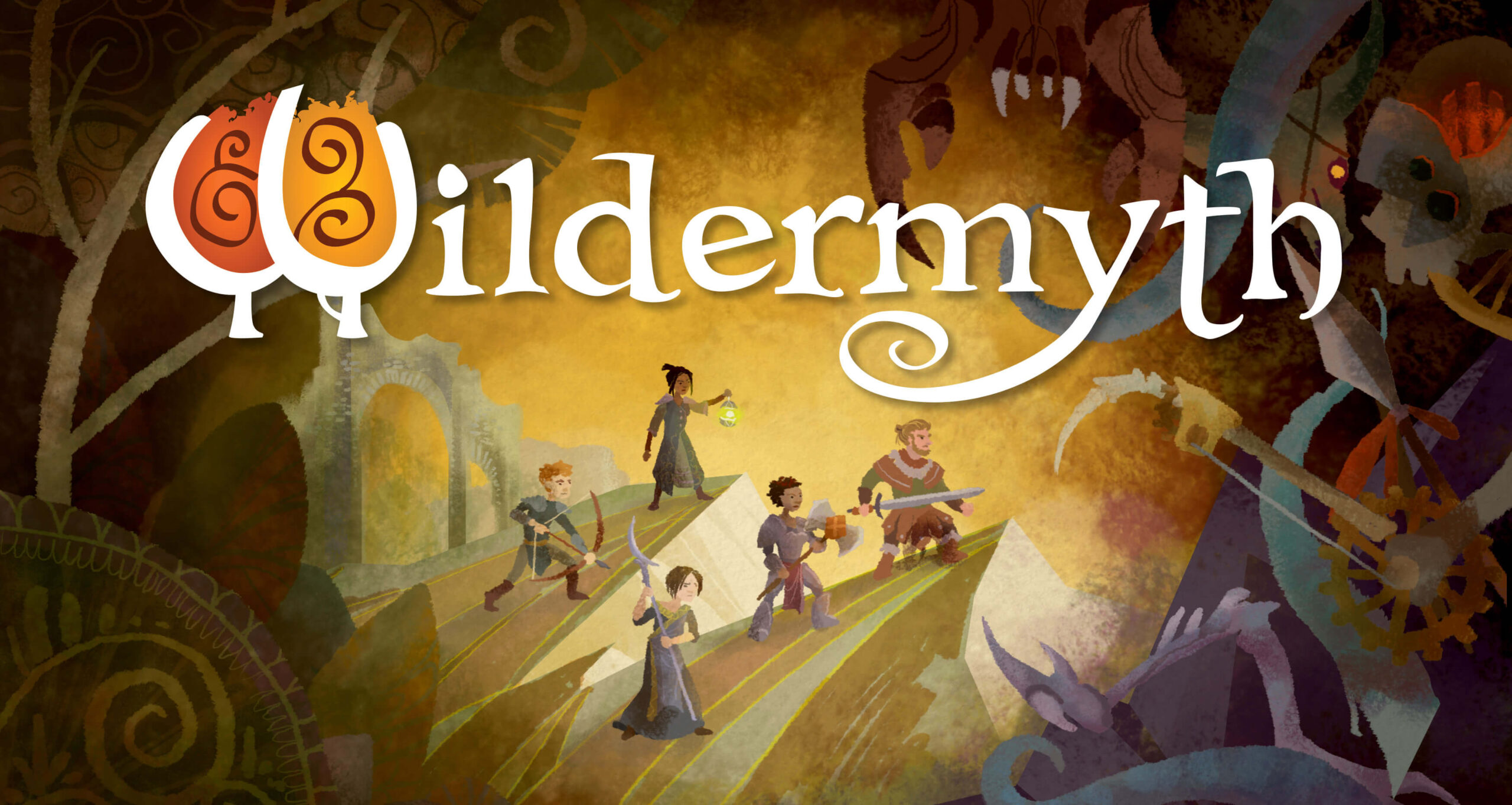







Excellent review of a largely unique game. I’ve never played anything similar to this (and I’ve played PC games since they were on mainframes with punch cards).
I quibble about a couple of things. The customization choices are random and you must spend legacy points to reroll your options (a very costly choice). Sometimes you get great options – and other times your characters are severely sub-optimal.
The archer/scout character is quite underpowered compared to the straight fighter and the mage. There are a lot of terrain features which provide cover from missle attacks – which means your ranged fighters are a huge hit & miss affair. This is a good game feature – but I suggest that you only take one archer as a scout (they can go “invisible.”)
The magic system means that there must be objects for the mage to infuse. After so many uses (depending on the object size) it is used up. Also, there are a limited number of items and higher level battles have enemies that “sweep” the board of objects that your magic can infuse. As a result, I’m not sure that more than one mage is very useful in more critical battles. If you get the right options (again, based on luck) you can specialize in a form of magic and “seed the ground” with objects to infuse with your magic – but this depends on getting the right options when you level up (which happens very rarely).
However, I concur with the review that this is a very enjoyable and different game. This is not a “power gaming” RPG and has far more, non-linear story telling. You have relatively few choices – which matter. The characters have more personality than most RPGs – but not as much as say Minsc from Baldurs Gate.
[Comments based on completing the intro campaign and midway through a random campaign].
Hi Avery. Thanks for taking the time to read [what is even for me] a very long review. I enjoyed the game alot as well. I also found it rather unique too.
Re: customisation choices the way I saw it was that you never really had the choice to customise the character exactly how you wanted. Rather they were fated to go a certain way. Which is why you wouldnt necessarily bring those legacy in future adventures. Essentially making do with sub-optimal characters for that adventure and not the next. Keeping in mind what the core design is for this game.
Re: I actually used archers alot. One of my preferred strategies was to have two of them scout out and take down fast moving enemies that got to close. Using a warrior/mage combo to take out the bigger ones. This worked for me.
I would avoid those behind terrain. Using magic to remove the cover. Or flank them while invisible. If that makes sense. Its been a while.
Re: I agree with what you write. Thats why I preferred only one mage in my party. I was flexible ofc.
Re: Agree also with the personalities. I think its one of the few times Ive actually taken the time to read every written part of the dialogue/narrative.